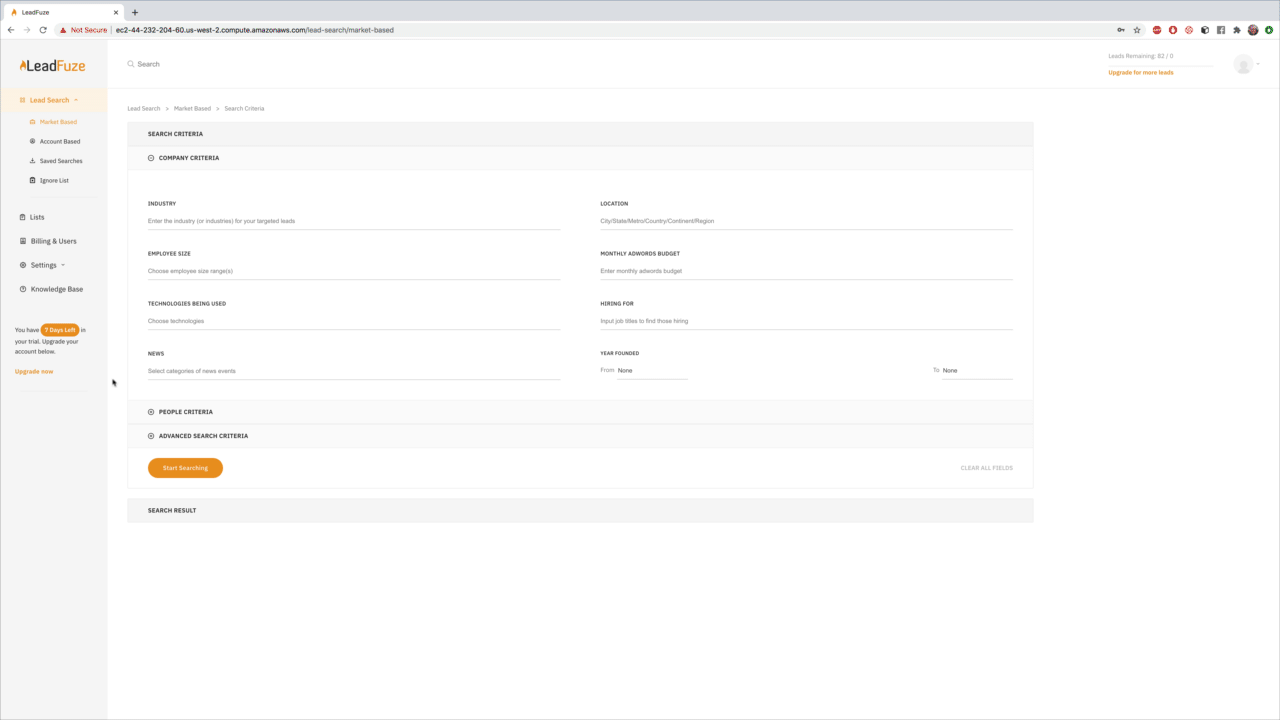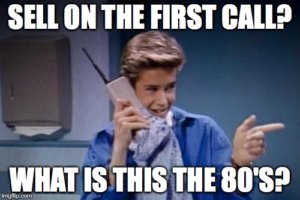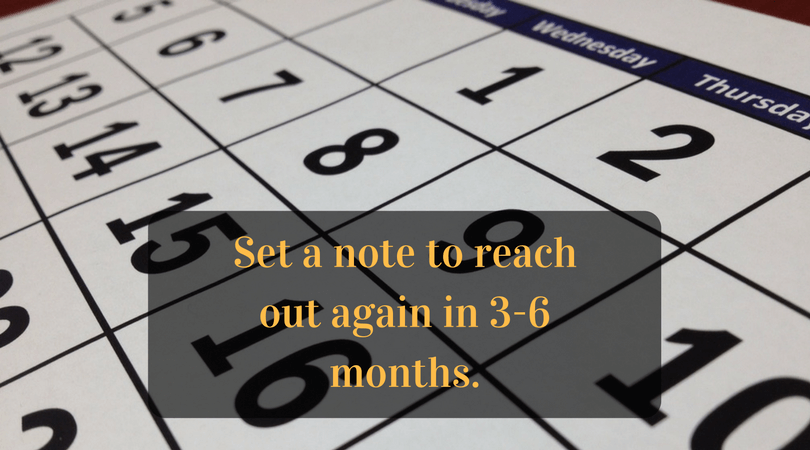The Cons of Not Following Sales Process Steps
Getting customers for your clients is something you’re good at. Consistently acquiring clients yourself can be challenging when you are focused on client work, not to mention you don’t have your sales process steps defined.
You may have noticed that businesses in your funnel seem to dance around and it looks like leads aren’t going in a very clear pattern.
It’s because they’re not.

No, the problem isn’t (necessarily) your content or the leads.
Nowadays, people like to simmer things for a while. Go back and forth, download several resources, and move around until they are extremely comfortable.
But that doesn’t help your marketing agency grow.
To get around this issue, you have to provoke leads in your pipeline down the path toward sales—starting from the very beginning with clearly defined sales process steps.
What is a Sales Process
A sales process is a set of steps that a sales rep takes to convert a prospect. It encompasses the entire customer journey, from realizing that there’s a need for a product or service, to making the actual purchase.
A good sales process is clearly defined, customer-centric, predictable, replicable, goal-oriented, and measurable.
A lot of sales teams don’t have a defined sales process, leaving it to individual reps to decide how they want to go about making the sale. However, most companies would benefit from having a defined sales process.
Importance of Sales Process Steps
More than 70% of businesses that follow a structured sales process are high performers, and generate up to 28% more revenue compared to businesses that don’t have a defined sales process.
It’s been shown that performance, forecasting accuracy, and revenue all go up once companies develop and adopt a standardized sales process.
Having a defined sales process allows you to gain a better understanding of what is and isn’t working and helps you identify bottlenecks in the way you do sales.
It helps sales reps stay on course by giving them a clear roadmap they can follow in order to move prospects from one stage to the next. This, in turn, enables sales managers to understand where each rep is in the sales process and use that information to improve sales forecasting.
The repetitive nature of a standardized sales process also promotes continuous improvement, which results in ongoing refinement of the process itself.
Sales Process vs. Sales Methodology
While they might seem similar at first glance, sales process and sales methodology are two completely different concepts.
While a sales process focuses on deals and opportunities, sales methodology serves to guide sales reps in how they’re going to approach each step of the sales process. It’s usually developed by a consultant or a sales training vendor.
A sales methodology isn’t applied to a company’s entire sales cycle but rather focuses on a single area of the sales process to create unique strategies that will help the company reach its goals.
There’s a wide variety of sales methodologies being used today. Some of the most popular ones include SPIN Selling, Solution Selling, Insight-Based Selling, and Challenger Selling.
4 Sales Process Steps to Follow
In this guide, we’re going to go over our 4-step sales process model which consists of the following stages:
- Connect: Finding the right leads and getting them to respond.
- Qualify: Making sure they’re in the right place and at the right time.
- Close: Getting them to say yes to your stuff.
- Deliver: Having a process to continue the relationship.
Step #1: Connect

Connecting is all about getting the right people who either don’t know you at all or know you a little bit to speak with you (or a rep).
There are two ways to do this — prospect cold leads (outbound and/or inbound).
I know it seems like we’re biased, but we really do love both.
Our specialty is helping people warm up cold leads via email, but we also publish a ton of long-form content, resources, and have some decent-sized inbound-esque plans for the future.
Try not to judge a company by its logo : )
Too many people are either one or the other. But the growth that can be achieved through a combined strategy is mind-boggling.
So, if you’re all inbound and haven’t considered outbound — it could be why you want to read this post.
That said, we are going to be concentrating on outbound sales.
Connecting starts with you, not picking up the phone. We’re not firmly in the “cold calling isn’t dead” side of that battle, but you have to define it right for it to work.
There are plenty of ways to generate leads without cold calling.
You have to start with who you want to talk to. Who you would love to see become customers. Share on XInbound usually attracts via resources, blogs, etc. Then, reps look at personas to make sure they are a good fit. Outbound starts with the ideal buyer in mind before your leads even know you’re coming.
Targeting the leads you’d like to become clients can dramatically hone your marketing resources while simultaneously reducing the sales process steps needed.
We’ve written a post about this here, but here are the quick tips for picking your favorite leads:
- Look at your (current) clients: Before you send your first-ever cold email, you’ll need an idea of who you’re going after. The best way to find them is by looking at your current client roster. Who’s your favorite type of account? Why? What do they all have in common (e.g. revenue, number of employees, industry)? Use that to develop a target lead.
- Develop your pitch: You can’t just ask them if they wanna buy your stuff. It’s more of a matter of selling what they want to achieve and then establishing yourself as the service or agency that can bring in those results. That’s going to take a little content marketing (e.g. white paper, webinar, other resources). Send them something that’s valuable and they’ll be more likely to reciprocate.
- Automate the process: Believe it or not, your entire cold outreach strategy can be automated. From finding the leads that fit your prospect profile to sending out multiple emails to those leads and even stopping the sequence when a lead responds to an email. It can all be low-touch, allowing you to concentrate on gaining and servicing the account.
What you’re after: The connect stage transitions into the next when a lead actually responds to your outreach efforts. Meaning they email you back or answer the phone. They’ll move to qualifying or just tell you to leave them alone — either way is fine.
Do you want to find more prospects?
LeadFuze is a lead generation software that helps businesses generate leads. It’s easy to use and has an intuitive interface. You can quickly create campaigns, manage your budget, and track the results of your campaigns in real-time.
It can help you find new customers for your business without breaking the bank or wasting time on tedious tasks like finding contacts manually. The LeadFuze system will do all the work for you while you focus on what matters most – growing your business!

Sign up for a free trial of LeadFuze!
Step #2: Qualify

Qualifying the leads in your pipeline means something completely different in outbound lead gen.
Inbound (usually) qualifies the lead based on buyer profiles and leads interact with the brand (e.g. content engagement, call-to-action, etc.) Outbound goes from unaware to connecting (getting a response from your outreach) as fast as possible.
Once you connect with a lead, you want to see if they’re a fit for your services (a.k.a. qualify them) which will usually take place via phone call.
Reps will get on the phone with these leads in order to see where they are in the buying process. Share on XThere are questions that need to be answered before you try to close. And you find out the answers to those by asking leads some questions that extract the data you need before you try to close.

We have a post for this, too (if you want to check it out) but we’ll go over the basics of what you need to find out.
- Make sure the pain’s there: Some of your questions have to be if the pain is significant to the contact that makes the decisions. For instance, if you’re selling review management to restaurants, the owner has to hate their Yelp! reviews. If they’re happy with their reputation, it’s not going to work out in your favor.
- Make sure the motivation is there: Ask things about how satisfied they are with current providers. Or, you could make it about their growth and see how hungry they are for better marketing.
- Make sure the time is right: Talking turkey needs to happen before a sales call. Here, you want to find out how much they’re currently
wastingspending on their marketing. Most companies in the right revenue range (not too small or big) have a big ad spend, but aren’t getting any metrics to track results — making them an easier sell.
What you’re after: Once a lead is qualified, you want to schedule a call to layout your marketing strategy that is a bit more tailored to this lead (not that you know them a bit better). Don’t sell on this call. Get them excited to hear about the results they can achieve.
Step #3: Close

Hopefully, you’re on a call with a genuine prospect that has quickly gone from unaware lead to ready to buy.
If that’s the case, you’re ready to paint a picture of the results and the process that you will use to bring them about.
This is when you’re going to fight the battle of objections. This is when you’ll ask for their business.
Wouldn’t you know it, we have a post about this too (told you we like inbound).
- Sell results, not services: You’re not trying to tell leads about how awesome you are at PPC. But you are trying to tell them exactly how you’ll increase their results (and using PPC may be a big part of that, but it’s not what they’re buying).
- Overcome objections: Better knowing the leads you’re going to reach out to is going to help you understand the specific objections of both the specific industry and role you’re dealing with. It’s like having a cheat sheet for the test.
- Ask for the deal: Once you’ve gotten any hangups, it’s time to ask if they want the results you know you can provide. It’s actually a good idea to ask leads to give you a definitive yes or no at the end of the call before you even start your presentation (e.g. Once I give you the strategy for your business, will you give me a straight answer?).
What you’re after: I think you know the answer to this one. You’re after the sale, but you’ll likely still get a maybe from more than a few leads. Don’t give up on them completely. Set a note to reach out again in 3-6 months.

“The customer doesn’t care about features – they care about solving their problems.” — Trish Bertuzzi
Step #4: Deliver

Once you have the sale, the work begins. You start delivering on what you promised is what you do.
That said, there are several things that could help or improve the mood of your new clients even more. You want their business for as long as possible, but there’s more to it than just giving them what they ordered.
Doing some post-sale work can move the needle in the right direction. Share on XAt a minimum, you should be doing this to get referrals:
- Communicate via drip: Agencies do a lot of stuff. Many of the services you provide may not be included in your original offer to clients, but they could still use them. Send them a steady stream of emails that offer value and talk about some of the other things you do.
- Ask for a referral: When the relationship is new and your clients start seeing the results is a great time to ask for a referral. The post above is almost entirely about setting up a program that will give you a steady flow of new business.
- Do a good job: You can sell, talk, and ask without performing. It’s always a good idea to ask yourself honestly whether or not you’re doing a good job for your clients. Call them up and ask them after a little while. Set up metrics to prove to yourself and your accounts that things are moving forward.
What you’re after: Delivering a good result is about doing the right thing and getting the most out of each account. The goal is to increase the lifetime value of clients and get referrals — all of which help you grow.
How to Map Out Sales Process Steps
A sales process map will help you visualize your sales process, as well as keep it organized. To map out your sales process, you’ll need to perform an analysis of the process itself, map your buyer’s journey, and define exit criteria for all stages of your sales process.
Analyze current sales process steps
To create a sales process map, start by analyzing your current sales process.
Find out what’s working for your sales reps (and what isn’t) so that you’re able to fine-tune your process and help your reps close more deals. You can do this by observing your reps as they work.
Analyze the deals they close by looking at how long it took to close each deal and what steps were required to close it. You’ll then be able to define the specific actions that helped move prospects to the next stage of the sales process.
Map buyer’s journey
The next step is to lay out the buyer’s journey for your target personas. This will enable you to see your sales process the way your customers see it.
Looking at your target audience’s buyer’s journey will help you gain a better understanding of your prospects’ pain points and challenges, and provide you with insight into how they interact with your sales reps.
This will allow you to make the appropriate changes to your sales process to ensure that sales reps have all the resources they need to develop strong relationships with prospects and make more sales.
Define exit criteria for all stages of the sales process
Once you’ve mapped your buyer’s journey, you’ll need to define exit criteria for every stage of your sales process. This will involve identifying everything that needs to happen for prospects to move from one stage of your sales process to the next.
After you do this, it’s crucial that you ensure that your sales reps have everything they need to move prospects from stage to stage. This includes brand and product information, supporting content, and answers to the most common objections.
Measure sales process performance
It’s crucial that you measure the results your sales process generates. This will allow you to understand how the sales process is working and how your sales reps are doing.
It will also provide you with relevant data that you can use to make informed decisions regarding optimizing your sales process to achieve better results.
4 Common Sales Process Steps Mistakes to Avoid
You’ve learned a lot about the sales process today. However, one thing we haven’t touched on yet are common sales process mistakes you need to avoid if you want your sales team to be successful.
These include:
1Lack of alignment between the sales process and the target audience’s buyer’s journey
Building out your sales process without taking into consideration your target audience’s buyer’s journey is a huge mistake.
You need to put yourself in your customers’ shoes when creating your sales process and tailor it to your target personas by making sure it addresses all of their needs, challenges, goals, and concerns.
2Not having clearly defined sales process steps
It’s crucial that you define the specific actions that help to move prospects from one stage of your sales process to the next.
If you leave these open to interpretation, your sales reps won’t have a clear understanding of what does and doesn’t work for your prospects, which will often result in them mishandling one or more parts of the sales process.
Make sure to document all parts of your sales process, and then share and practice it with your team.
3Not refining the sales process continuously
Your work isn’t done once you define and document your sales process. You should continuously be refining it and finding different ways to improve it and enable your reps to generate better results.
In order to improve your sales process, you’ll need to make sure to measure your sales team’s results and have regular check-ins with your sales reps to discuss any new issues or bottlenecks in your sales process.
Remember to implement changes gradually, and consider your sales team’s limitations, as well as its adaptability to the changes you want to make.
4Lack of training for sales reps
Even if you manage to create the perfect sales process, you won’t be getting consistent results if you don’t take the time to provide proper training to your sales reps.
You need to have regular training sessions with your reps, and purchase or develop sales training tools that will help reps improve their skills and their understanding of your sales process.
The best way to approach sales training is to identify key skill gaps your reps have, and then focus your training sessions around helping reps develop those skills so that they’ll have an easier time dealing with prospects and closing deals.
How to Optimize Sales Process Steps
If you want to keep making sales and growing your company’s revenue, it’s important that you continuously work on optimizing your sales process.
In most cases, this will involve finding ways to automate or simplify tasks in your sales process to make it easier for your reps to make sales.
The best way to start improving your sales process is to determine areas of the process that are either inefficient or ineffective and then focus on optimizing those areas.
1. Identify leaks and bottlenecks
Most sales teams focus on the end part of the sales process, putting little thought into possible issues at the beginning and middle of the process that might be causing a reduction in sales.
You’ll need to map out your entire sales process to be able to visualize all the steps your sales team takes to convert a prospect into a customer.
This will enable you to pinpoint possible leaks and bottlenecks, and then perform the necessary adjustments to either fix or improve parts of your sales process.
2. Define a process for measuring and tracking KPIs
To be able to improve your sales process, you need to know how it’s performing. This means that you need a defined process for measuring and tracking your KPIs (Key Performance Indicators).
Developing this process will involve identifying your KPIs while discerning between performance and vanity metrics, and finding ways to automate data collection so that your team doesn’t waste team on manual tracking and data entry.
3. Shorten the sales cycle
Finally, one of the best ways to optimize your sales process is to work on shortening the sales cycle. Find different ways to close deals faster, and reduce back-and-forth and lag time in your sales process.
Here are a few ideas you should consider:
- Plan your sales calls in advance and set a clear goal for every call you make. Strive to book the next call at the end of each call.
- Explore prospects’ objections and address them as soon as possible. Try to get prospects to commit to a specific timeline early in the process.
- Automate any repetitive tasks your sales team deals with on a regular basis, including email prospecting, follow-ups, CRM data entry, and proposal creation.
- Use digital contracts and make it as easy as possible for prospects to sign them from any device, including smartphones and tablets.
Conclusion
One of the coolest things about these sales process steps is that it can be added to the way you get clients already. Running ads, traffic and any other methods don’t have to be stopped to give this process a shot.
Do you use any of these sales process steps for your business? We’d love to hear about how you are gaining clients.
Want to help contribute to future articles? Have data-backed and tactical advice to share? I’d love to hear from you!
We have over 60,000 monthly readers that would love to see it! Contact us and let's discuss your ideas!

